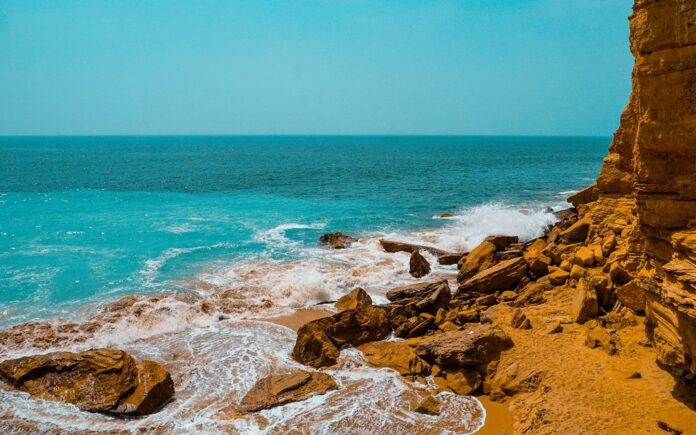Many developing nations around the world have been said to be mostly dependent on coastal tourism for their economic growth. But in Pakistan, the significance of seaside tourism has scarcely been acknowledged. Since the China-Pakistan Economic Corridor (CPEC) was inaugurated, the nation’s socioeconomic development has centred on coastline tourism. Coastal tourism necessitates a thorough planning framework for its sustainability, despite being a complicated activity encompassing several sectors, levels, and interests.
This study aims to identify potential prospects and difficulties for the development of coastal tourism in the country, taking into account the significant economic significance of coastal tourism in the corridor. 37 stakeholders in coastal tourism provided data for this study using a semi-structured interview programme.
There are plenty of natural riches in this unexplored area of Pakistan, and the unspoiled beauty of the coast deserves recognition. It also has some strategically significant areas, such Ormara and Gwadar. Pakistan’s coast has the potential to develop into a significant hub of economic activity due to its advantageous position and possibilities for tourism and commerce.
The Coastline of Pakistan Is Strategically Important
The Sea Line of Communication (SLOC), which connects Gwadar, Karachi, and other locations to the Gulf of Aden and the Persian Gulf, gives Pakistan’s coast strategic importance. Gwadar now serves as a crucial strategic port for China’s and Pakistan’s “One Belt, One Road” programme. Furthermore, Karachi is the only maritime terminal that is physically next to India on Pakistan’s east coast. Pakistan places a high value on the establishment of vital infrastructure along its coastline for these reasons.
Pakistan’s Coastal Line’s Total Length
Pakistan’s coastline stretches between 990 and 1046 km in total, or 650 miles in kilometres. Furthermore, Pakistan’s coastline extends from the province of Sindh to the province of Balochistan. However, Balochistan, which spans an estimated 770 kilometres, contains the majority of the coastline. It has also brimmed with potential as a natural gold mine.
Incompetence Along Pakistan’s Coastline
Pakistan, like a lot of other nations, can profit from its coastline regions. There are 700 miles of stunning lakes and sandy beaches in our nation, all of which can be used for prosperous tourism. What Pakistan can do to promote the nation’s coastal tourist sector is the question. Pakistan saw great success in its tourism sector in the early 1970s. Every day, sailing vessels adorn the harbour for the enjoyment of both domestic and foreign visitors. People’s favourite spots to hang out are the restaurants and cottages on the beach. Families and youths congregate at places like Hawke’s Bay, sandpits, and the beaches and boating basins at Kamari.
Pakistan’s Coastal Tourism
The general public’s attitude towards beaches and coastal tourism is another factor contributing to the current situation of coastal tourism. The general public thinks that the tourism industry, which has taken over world-class beaches, is to blame for the gradual erosion of their moral and social values. Travellers, both domestic and foreign, have a great deal of difficulties as a result of this mindset since it prevents them from engaging in these activities freely without fear of judgement. We need to inculcate principles that make visitors feel at ease if we hope to expand the amount of coastal tourism.
Coastal Travel in Our Adjacent Nations
Policies are being released by other South Asian nations to encourage the growth of the maritime industry. For instance, India’s national budget included $11.8 billion for the maritime industry. The World Bank has awarded Bangladesh 240 million US dollars for initiatives aimed at enhancing coastal regions and fishing capabilities. Furthermore, coastal tourism alone has brought Bangladesh up to $1.567 billion in income, although previous assessments of its coastline were not as flawless as ours.
The coastline of Pakistan crosses the Arabian Sea as follows:
- Pasni
- Omara
- Jiwani
- Gwadar
- Sonmiani
- Karachi
- Indus Delta
- Taiwan
A wetland close to Jiwani City in Balochistan, Pakistan is called the Jiwani Coastal Wetland. The location, first opened in 2001, is one of Pakistan’s 19 Ramsar wetlands. The location and site are situated in the Dashte River Delta, close to the town of Jiwani in the Gwadar District of Balochistan, on the edge of Jawatil Bay. The marsh extends westward to the Iranian border and is close to Yovatir Bay in Iran, with a total area of 11,367 acres. Gawwater Bay and Jovatir Bay are the two bays that comprise the bay waters. Sandy beaches and steep cliffs may be found on the “Dran” (east) side of the coast. The land is level and the marshland is low near the Iranian border. There is little rainfall in the area and a dry climate. The primary source of freshwater and mangroves in the area, as well as the primary conduit for monsoon runoff from neighbouring hills, is the Dashte River. Mangroves and beaches are the two primary biological areas that Jiwani Coast offers for its fauna and flora.
KARACHI
Karachi is situated on a coastal plain that is dotted with hills, coastal mudflats, and rock outcrops. Coastal mangroves stretch towards the wide Indus River delta to the southeast, growing in the saltwater surrounding Karachi Port. Cape Monzi, often referred to as Cape Morey locally, is located west of Karachi and is distinguished by sea cliffs, steep sandstone promontories, and undeveloped beaches.
GWADAR
China’s “One Belt, One Road” project has identified Gwadar Port as one of the most strategically important ports in recent years. The Persian Gulf’s mouth is home to Gwadar. The China-Pakistan Economic Corridor and the Maritime Silk Road are two of its main tenets. Both have significant strategic importance because they are a part of the “One Belt, One Road” plan. This leads many to assume that Gwadar is a military facility used in conjunction with China. Gwadar is still primarily used as a commercial port, nonetheless. Ensuring the safety of high seas ports and prospective commercial centres in the region is the aim of the Gwadar naval base.
Pasini
Between Ormala and Gwadar is another port city called Pasini. There is a commercial port planned, and local fisherman use the fishing port extensively. The use of Passini as an airfield during World War II by Allied forces is a key strategic consideration. The abandoned airport subsequently saw the construction of a new runway in 1988, and PNS Makran, a coastal naval air station, was established. After PNS Mehran in Karachi, it is the second naval aviation station in Pakistan. Following the base’s 2003 connection to the Markland Coastal Highway, the Pakistan Air Force, Pakistan Navy, and Civil Aviation Administration all share use of the airport.
About 385 kilometres to the west and 285 kilometres to the east are Omara and Ormara’s respective locations from Karachi and Gwadar. It’s a little town situated in a different part of the country than Gwadar. It forms a hammer that connects the sandpit to the mainland, making it the perfect place for a deep seaport. Since it was constructed and opened in 2000, the Pakistan Navy Jinnah Naval Base has benefited from the cliff’s location and the hammerhead sharks that act as the base’s natural camouflage.
Bay of Sonmiani
In Pakistan’s Balochistan Province, Sonmiani Bay is situated in Ras Bela District by the Arabian Sea. It takes twenty-eight minutes to get from Hub to Sunmiani Bay. Between Hub and Sonmiani Bay, it is roughly 24 kilometres (14.9 miles) or 13 nautical miles by car. The amount of time needed for the car to go that distance is referred to as the journey time.
River Indus Delta
Where the Indus River empties into the Arabian Sea is where the Indus Delta is created. It is mostly found in the southern Pakistani province of Sindh, with a tiny portion being found in the Kuch region in western India. The delta’s area is roughly 41,440 square kilometres, and it is about 210 kilometres wide where it meets the sea. The delta activity area is 6000 square km in size. The region experiences dry weather, with 25 to 50 cm of rain falling there on average each year. Along with an abundance of fish, birds, and Indian pufferfish, the delta is home to the largest arid mangrove forest in the world.
Last Words
Pakistan has enormous potential for coastal tourism. Furthermore, Pakistan attaches strategic and economic significance to the coastal line. Nonetheless, Pakistan’s largest and most promising coastline region is Balochistan. In terms of geography, it is also highly significant and gives Pakistan a tactical edge. In Pasni, Kund Hub, Gadani, and Jiwani along the coast, soil erosion has occurred as a result of changes in climate and structural evolution.



